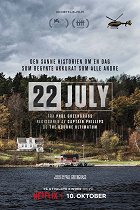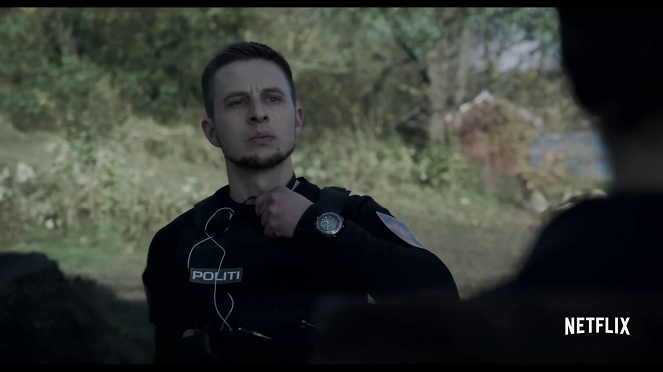Directed by:
Paul GreengrassScreenplay:
Paul GreengrassCinematography:
Pål Ulvik RoksethComposer:
Sune MartinCast:
Jonas Strand Gravli, Thorbjørn Harr, Anders Danielsen Lie, Seda Witt, Lars Arentz-Hansen, Jon Øigarden, Anneke von der Lippe, Øystein Martinsen, Maria Bock (more)VOD (1)
Plots(1)
Paul Greengrass tells the true story of the aftermath of Norway’s deadliest terrorist attack. On 22 July 2011, 77 people were killed when a far-right extremist detonated a car bomb in Oslo before carrying out a mass shooting at a leadership camp for teens. 22 July uses the lens of one survivor’s physical and emotional journey to portray the country’s path to healing and reconciliation. (Venice International Film Festival)
(more)Videos (1)
Reviews (10)
The final interpretation is admittedly pretty one-sided, but on the other hand it's probably fair to admit that Greengrass’ hands were tied in this respect – by which I mean the "political tone" of his adaptation. It bothered me that it didn't go more in depth in the second half, and that the whole courtroom part served primarily to rehabilitate survivors and victims. In short, I feel that such a serious subject deserved a much deeper analysis of the political and social aspects. The opening in Oslo and then the scenes in Utøya are very intense; the rest of the film is unfortunately a bit one-sided. 4 stars by the skin of its teeth. [70%]
()
I am reluctant to use the word “complex”, which for me means a film that offers numerous opposing perspectives and ambivalent impressions, which is not the case in Greengrass’s factually concise docudramatic reconstruction, in which he constructs two relatively unambiguous ideological positions (similar to Bloody Sunday), which he pits against each other so that he can offer the intended political statement in the end (threats against Lippestad only bring shades of grey into the narrative, but they are not laid out in greater detail and can also be seen as a means of supporting the argument for the power of democracy, which, regardless of the possible risks, cannot serve only those who deserve it, but everyone). ___ Good versus evil, love versus hate, a deranged individual versus a community which, thanks to mutual support and cooperation following the trauma, can get back on its feet and face evil. With his movements, cold-blooded thinking and belief in his own infallibility, Breivik is reminiscent of a machine. If we learn anything about his motives, it is from his mother’s statement, which the attorney needs because of the trial, or thanks to the fact that he has become a research subject for psychologists. In the scenes from the prison with a predominance of cold colours, he is aggressively set apart from his surroundings by his red shirt. Conversely, through flashbacks and subjective sounds, we “see into the mind” of the traumatised, insecure and vulnerable Viljar and get to know him in a number of situations with his supportive loved ones in which he gives expression to his emotions. We not only observe him, but we experience who he is. Instead of a “traitor”, a “Marxist” or a “member of the elite”, as Breivik blanketly labels his victims, we get to know an actual person and his story. As we are shown through numerous parallels in the way the two figures are depicted, Viljar is not from a certain moment most at risk from the wounds that he suffered, but rather from the possibility that he, like Breivik, is starting to become isolated from others and will stop seeing himself as a member of the broader community.___ The rhythm of the smoothly flowing narrative is masterfully set by the large number of viewpoints between which Greengrass cuts. After the dynamic beginning, which offers a broad variety of rapidly alternating viewpoints, a calming occurs and we watch only Breivik and Viljar for a moment. If the narrative jumps to another character, thanks to the prologue we are already familiar with them and we know what role they play in the web of relationships and what element of Norwegian society they represent. After this slowing down and narrowing of focus, the film also transitions from individual actions, recorded step by step almost in real time, to their more general sociological and political implications. Of course, they still serve mainly to support the arguments employed in the final trial. The whole film is a textbook example of how to apply dialectical logic in practice. It does not try to depict the reality of polarised Europe in all its complexity, but rather as a clash of two principles, which it succeeds in doing in a very factual and extremely suggestive manner. 85%
()
(less)
(more)
22 July is a smart and suggestive portrayal of an awful human act that attacks the roots of democracy, but that also shows the madness of those who violently try to undermine it. Though it pushes the viewer to only one correct interpretation, its complex approach forces you to think about where humankind is heading and all of what we are capable of. Despite being impossible to get into the minds of the characters, this is an intense experience that, through the traumatising initial disaster, shows an unflattering face of a Europe that today is divided and living in fear. This is despite the fact that it has an inevitable tendency to generalize problems.
()
Paul Greengrass serves up a dense psychological drama about the July 22, 2011 terrorist attack in Norway that killed 77 people, and he perfectly captures the horror everyone there experienced. There was another attempt this year, from Norway, Utøya: July 22, but that one didn't work very well from my point of view, it's presented in an overly documentary and boring way, no one dies and they don't even show Breivik himself. Greengrass, in contrast, describes in detail how everything took place and literally draws the viewer into the film. The opening explosion and the subsequent merciless murder of the students on the island is excellent (here the director could have spent more time than 15 minutes, but emotionally and psychologically it affected me just the same). I also praise the performance of one of the survivors, Viljar, who survived five gunshot wounds and still has to live with lifelong consequences. The film culminates in a dense trial where emotions are not spared and the hatred towards Breivik is spot on. Solid stuff. 75%
()
Paul Greengrass is a master of immersive atmosphere and has reaffirmed it with this film. If someone seems to find the scene of the absolutely crazy massacre rushed and non-captivating, I feel really sorry for them (and it may well be the founder of FilmBooster), because I haven't seen anything more repulsive in a long time. Besides Greengrass, the representative of Breivik, from whom radiates unadulterated fear, does his share, and the longer he is in the film and when he turns into an exquisite psychopath from an originally silent character, then that fear is even greater. In addition to Breivik, we also see the consequences of his actions, which one of the families must deal with, we will also get to know his attorney and feel the pressure on the Prime Minister of Norway... It seems to me that the film really had everything. I can't say I enjoyed watching it, but it was one of those memorable experiences. I guess like... Well yes, probably like Greengrass' United 93.
()


